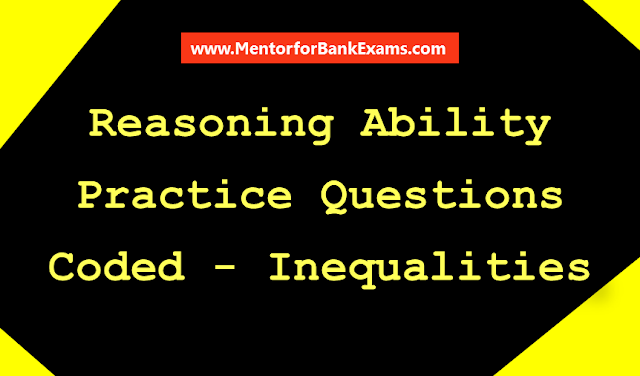Reasoning Ability Coded – Inequalities Practice Questions (11 – 09 –
2017)
Directions (1 – 5): In the
following questions, the symbols $, @, £, • and # are used with the following
meanings as illustrated below:
‘A $ B' means A is neither greater
nor smaller than B
‘A @ B' means A is neither greater
than nor equal to B
`A £ B' means A is neither smaller
than nor equal to B
‘A • B' means A is not smaller than
B
In each of
the following questions, assuming the given statements to be true, find out
which of the two conclusions I and II given below them is/are definitely true.
Give answer
a) if only conclusion I is true.
b) if only conclusion II is true.
c) if either conclusion I or II is true.
d) if neither conclusion I nor II is
true.
e) if both conclusions I and II are
true.
1. Statements: W • P,
P £ G, G @ I, I # N
2. Statements: U @ D,
D $ E, E £ Y, Y • W
Conclusions: I. W @ E II.
D £ W
3. Statements: Z £ N, N # K, K $ M, M @ R
Conclusions: I. M $ N
II. M £ N
4. Statements: V • D,
D £ T, K $ T, K # F
Conclusions: I. D £
K II. T • F
5. Statements: S $ Q,
Q @ B, B • K, K # W
Conclusions: I. K # S
II. S @ W
Directions (6 – 10): In the
following questions the symbols @, +, ©, $, ∆ and ? are used with the
following meaning:
P ∆ Q means P is not equal to Q.
P @ Q means P is greater than Q.
P + Q means P is smaller than Q.
P © Q means P is either greater than
or equal to Q.
P $ Q means P is either smaller than
or equal to Q.
P ? Q means P is equal to Q.
Now in each
of the following questions assuming the given statements to be true, find which
of the two conclusions I and ll given below them is/are definitely true. Give
answer
a) if only conclusion I is true.
b) if only conclusion II is true.
c) if either conclusion l or ll is true. .
d) if neither conclusion I nor ll is true.
e) if both conclusions I and ll are true.
6. Statements: K © M, M ∆ R, R ? T
Conclusions: I. K © T II. M ?
T
7. Statements: B+D, D@N, N$H
Conclusions: I.H©D
II H©N
8. Statements: M©K,
K@P, P$N
Conclusions: I. M@N
II.M?N
9. Statements: T$M,
M?Q, Q+R
Conclusions: I. Q @ T II.Q ? T
10. Statements: D @ B,
B$T, T + M
Conclusions: I.M@B II.T©B
Directions (11 – 15): In
the following questions, the symbols @, $, %, # and © are used with the
following meanings illustrated—
(i) ‘X @ Y’ means ‘X is not smaller
than Y’.
(ii) ‘X $ Y’ means ‘X is not greater
than Y’.
(iii) ‘X % Y’ means ‘X is neither
smaller than nor equal to Y’.
(iv) ‘X # Y’ means ‘X is neither
greater than nor equal to Y’.
(v) ‘X © Y’ means ‘X is neither
smaller than nor greater than Y’.
In each of
the following questions assuming the given statements to be true, find out
which of the two conclusions I and II given below them is/are definitely true.
Give answer
a) If only I is true.
b) If only II is true.
c) If either I or II is true
d) If neither I nor II is true.
e) If both I and II are true.
11. Statements: P $ T, T @ L, U % L
Conclusions: I. P @ L II.
U©L
12. Statements: A @B,
B%D, D©K
Conclusions: I. A©K II.
B%K
13. Statements: J # K,
K©L, P$L
Conclusions: I. P$K II. J#L
14. Statements: T % O,
T # M, M@ V
Conclusions: I. M % T II. O % V
15. Statements: K @ T,
T # C, C $ P
Conclusions: I. C © K II. C % K
Solutions:
(1-5):
> → £; ≥
→ ∙; = → $; @ → <; # → ≤
1. d)
Statement-W≥P>G<I≤N
Conclusion- I>P, N≤W
2. e)
Statement- U<D=E>Y≥W
Conclusion- W<E, D>W
3. c)
Statement- Z>N≤K=M<R
Conclusion- M=N, M>N
4. a)
Statement- V≥D>T=K≤F
Conclusion- D>K, T≥F
5. d)
Statement- S=Q<B≥K≤W
Conclusion- K≤S, S<W
(6 – 10):
∆----
≠; @---- >; + ---- <; © ---- ≥; $
----- ≤; ? ------ =
6. d)
Statement-K≥M≠R=T
Conclusion- K≥T, M=T
7. b)
Statement- B<D>N≤H
Conclusion- H≥D, H≥N
8. d)
Statement-M≥K>P≤N
Conclusion- M>N, M=N
9. c)
Statement- T≤M=Q<R
Conclusion- Q>T, Q=T
10. e)
Statement-D>B≤T<M
Conclusion- M>B, T≥B
(11 – 15):
>---%; ≥---@;
=---©; <---#; ≤---$
11. d)
Statement-P≤T≥L<U
Conclusion- P≥L, U=L
12. b)
Statement- A≥B>D=K
Conclusion- A=K, B>K
13. e)
Statement- J<K=L≥P
Conclusion- P≤K, J<L
14. a)
Statement- V≤M>T>O
Conclusion-M>T,O>V
15. d)
Statement- K≥T<C≤P
Conclusion- C=K, C>K






